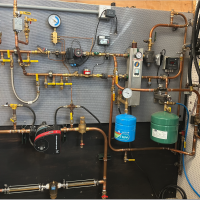Welcome! Here are the website rules, as well as some tips for using this forum.
Need to contact us? Visit https://heatinghelp.com/contact-us/.
Click here to Find a Contractor in your area.
flow rates for radiant in floor heating
Steve Latici
Member Posts: 2
I installed a radiant system in a concrete slab covered with tile. The system is now about 15 years old. For the first several years the system was great with wonderful heat transfer although there were a few cold spots. Lately however the system barely warms the tile whereas the tile used to get really hot. I though therer might be air in the system and I have tried to bleed the system repeatedly. Lately I have noticed that the flow rate through the system is barely a trickle and the temperature of the water in the return line is barely warm, probably 75 to 80 degrees. I know the circulator is running but is it possible that the circulator is wearing out and not pumping at the same rate when it was new? This is the only thing that I can think of other than the problem of air in the system. Should I just go ahead and replace the circulator and see what happens?
0
Comments
-
When was the last maintenance done?
Steve, it sounds like a system flush and restore is what you need, not just a pump replacement. In my experience the pump either works or does not, I have not come across one that has "slowed down". Also, if there is air in the system, where did it come from? This system has been operating "trouble free" for 15 years, I wouldn't expect air to be an issue at this point. Have you checked the air eliminator for blockage? If you don't have one already get a side stream filter installed, completely drain, clean and treat the system and then see what happens. JMHO.0 -
radiant heat system
Thanks for the reply. I suspected that circulators either work or they don't. I think the problem may be in the balancing valves. I will try your suggestion about draining the system and see if that makes any improvement0 -
Just make sure that you are using the right fluid
Steve, if you are going to drain down the system, 1st make sure you dispose of the fluid properly and not just down the drain, as it is most likely toxic. 2nd make sure that if you need glycol you put it in, in the right percentage, also if you need inhibitors you should check those levels as well. Good luck.0 -
what materials were used?
I have a couple of questions Steve. What type of tubing? do you have an oxygen barrier? what type of boiler? Antifreeze? If you have 15 year old antifreeze then it is probably very acidic by now and eating away at your system.
0 -
Any strainers, or filter ball valves
in the system? A good place to find a slow spot in the road.
If you can disconnect the tube circuit from the boiler you can power flush with a garden hose at pressure up to 100 psi.
But make sure the boiler with it's 30 lb relief and the expansion tank is isolated from that pressure.
The early PB systems were famous for sludging up tube. Same with some of the non barrier tube, Solar roll early Entran systems, even non barrier pex under the right conditions.
hot rodBob "hot rod" Rohr
trainer for Caleffi NA
Living the hydronic dream0 -
Pumps CAN go away after a time
I've seen plastic impellers get eaten away until nothing is left but a stump. It can't hurt to check it if your fluid is moving slow.0
This discussion has been closed.
Categories
- All Categories
- 86.7K THE MAIN WALL
- 3.1K A-C, Heat Pumps & Refrigeration
- 56 Biomass
- 423 Carbon Monoxide Awareness
- 102 Chimneys & Flues
- 2K Domestic Hot Water
- 5.6K Gas Heating
- 103 Geothermal
- 158 Indoor-Air Quality
- 3.5K Oil Heating
- 68 Pipe Deterioration
- 935 Plumbing
- 6.2K Radiant Heating
- 385 Solar
- 15.3K Strictly Steam
- 3.4K Thermostats and Controls
- 54 Water Quality
- 43 Industry Classes
- 47 Job Opportunities
- 18 Recall Announcements
